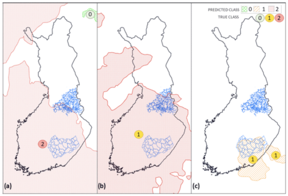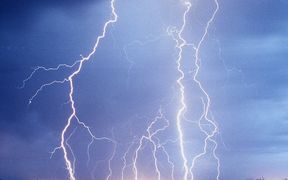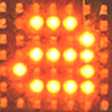AI predicts if storms will cause blackouts many days in advance

Examples of what damage the model predicted from three major storms Tapani (a), Rauli (b), and Pauliina storms (c). The colored areas show the storm predicted by the model, and their predicted damage level shown by the colour (red = major damage, yellow = minor damage, green = no damage). The numbers, in turn, describe the actual hazard class. The operating areas of the electricity network operators are shown in blue. Photo: Finnish Meteorological Institute / CC BY 4.0
In Finland, stormy weather can happen at any time of year. This is an issue because Finland is heavily forested, and falling trees can knock out power lines and disable transformers, causing power blackouts for hundreds of thousands of people a year. Researchers at Aalto University and the Finnish Meteorological Institute (FMI) are using artificial intelligence and machine learning to try and predict when these weather-inflicted blackouts happen. Their new method can now predict these storms days in advance, allowing electricity companies to prepare their repair crews before the storm has even happened.
‘Our previous model looked at highly local thunderstorms with short lifespans. We’ve now made a new mode that looks at large low-pressure storms, which uses weather prediction data up to 10 days ahead,’ said Roope Tervo, PhD candidate at Aalto University and software architect at FMI.
The model categorises storms into 3 categories : No damage; low damage (1 - 140 damaged transformers); and high damage (over 140 damaged transformers). It can predict the location of the storm to within 15 km, and the time of the storm to within 3 hours. Based on the test data, the model has a recall of approximately 0.6, which means that it has a 60% chance of correctly predicting which category a storm will be in. It also has an accuracy of approximately 0.8, which means that 80% of the storms the model predicts will do damage then go on to cause the predicted damage.
‘The geospatial and temporal resolution become more accurate as the weather models evolve. In 2024 the weather prediction geospatial and temporal resolution will be 5 kilometres and 1 hour, correspondingly.’ says Tervo, ‘The outage prediction accuracy can still be improved a bit. For example adding ground frost data and information about tree leaves would most probably improve the results. The prediction will, however, never be perfect. It is also good to remember that, when employing weather prediction data, errors are coming from both weather prediction and the outage prediction models.’
The thunderstorm prediction tool previously developed by the team at Aalto and FMI has been used by the power grid operators Järvi-Suomen Energia, Loiste Sähköverkko, and Imatran Seudun Sähkönsiirto. ‘Our new prediction is provided to them via the same user interface, and they are experimenting using the tool’ says Tervo.
The full research article “Predicting power outages caused by extratropical storms” is published in the journal Natural Hazards and Earth System Sciences and is available to read for free online here: https://nhess.copernicus.org/articles/21/607/2021/nhess-21-607-2021.html
Contact:
Roope Tervo
PhD Candidate
Aalto University
Tel +358 29 539 3651
Roope.tervo@fmi.fi
Machine learning helps to predict blackouts caused by storms
A collaboration between computer scientists at Aalto University and the Finnish Meteorological Institute applies machine learning to predict how damaging a storm will be

Read more news

A new way to measure contagion: the gut bacterium behind blood poisoning can spread like influenza
Neither the antibiotic-resistant nor the highly virulent strains are the most transmissible.
Cross-sectoral working group: Competitiveness, security and green transition must be promoted as a whole
A cross-sectoral working group for universities, businesses and cities is proposing that Finland speed up its international competitiveness, national security and green transition as one entity. The group suggests that, for example, defence procurement could support solutions aimed at a carbon-neutral society.
Call for Applications: Aalto Creatives Pre-incubator Programme Spring 2026
Join the Aalto Creatives afterwork and info session on 20.1.2026 to find out more about the open call and meet the Aalto Creatives team. At this event, alums from the pre-incubator tell about their entrepreneurial journeys and share their experiences from participating in the AC programme.






